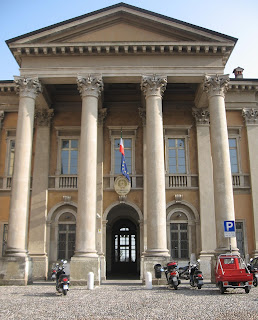 |
| Giorgio Gori has been Mayor of Bergamo since 2014 |
As television crews descended on the city, Gori was regularly interviewed on camera and thus was seen by audiences in many countries as the story of Covid-19’s devastating impact on Italy dominated news bulletins.
Gori’s own background is in the media. Educated in the magnificent surroundings of the Liceo Classico Paolo Sarpi in the historic Città Alta, he went on to study architecture at the University of Milan but also was keen to become a journalist. He began to contribute to local newspapers, including L’Eco di Bergamo, and the city’s own television station, BergamoTV.
In 1984 he joined the television station Rete4, which at the time belonged to the Arnaldo Mondadori publishing house and later became part of Silvio Berlusconi’s Mediaset stable. Gori worked for Mediaset for 15 years. Between 1991 and 2001, he was director of the three Mediaset networks, Rete4, Canale5 and Italia1.
It was through Canale5 that Gori met his wife, the journalist and TV presenter Cristina Parodi, who was one of the faces of Canale5’s flagship news programme, TG5, which launched in 1992. They were married in 1995, made their home in Bergamo and have three children, Benedetta, Alessandro and Angelica.
Gori left Mediaset in 2001 to partner Ilaria Dallatana and Francesca Canetta in setting up a television production company, Magnolia, which specialised in the development and production of original formats for television and interactive media. Magnolia collaborated with the Rai, Mediaset, LA7 and Sky networks and had some memorable successes, including the hit shows L'isola dei famosi, Piazzapulita, MasterChef Italia e L'eredità.
 |
| The neoclassical facade of the Liceo Classico Paolo Sarpi in the Città Alta |
He joined the centre-left Democratic Party (PD) and in 2012 worked as a close adviser to Matteo Renzi, then Mayor of Florence, as he prepared what was ultimately his successful bid to become prime minister.
In Bergamo, Gori set up the InNova Bergamo Association with the aim of studying the issues concerning his city and in 2014 was elected the city’s mayor, defeating the incumbent Franco Tentorio, who represented Berlusconi’s centre-right Forza Italia.
Gori failed in his attempt in 2017 to become regional president of Lombardy but in 2019 was re-elected as Mayor or Bergamo, the first to be returned for a second term since the position became subject to a public vote.
During the first Covid-19 lockdown in Italy, Gori - whose 62nd birthday is today - wrote a book entitled Riscatto - Bergamo e Italia: Appunti per un futuro possibile (Ransom - Bergamo and Italy: Notes for a possible future) in which he describes his life and professional experiences, the story of Bergamo during the first wave of Covid-19, and sets out his view of the path Italy must take to be reborn after the pandemic.
The Liceo Classico Paolo Sarpi, the high school attended by Gori, is an historic institution in Piazza Rosate in Bergamo’s Città Alta, opposite the rear entrance of the city’s cathedral.
Identifiable by its neoclassical facade designed by Ferdinando Crivelli, the Liceo has its roots in the first public school of Grammar, Humanities, and Rhetorics established by the Republic of Venice in 1506 under the name of Accademia della Misericordia. It was renamed after Paolo Sarpi, a Venetian polymath, in 1803, by Napoleonic decree.
The building that houses the modern school was built between 1845 and 1852 under the auspices of the Austrian Government, when it was known as Regio Liceo.
In 1860, the academy contributed to the Italian Unification with 70 students joining Garibaldi's Expedition of the Thousand, aimed at annexing the Kingdom of the Two Sicilies to the embryonic Kingdom of Italy. In 2011, the academy took part in the celebration of the 150th anniversary of the Italian unification, attended by the President of the Republic, Giorgio Napolitano.
Garibaldi famously referred to Bergamo as La Città dei Mille, because of the major role it played in the Expedition of the Thousand.
No comments:
Post a Comment